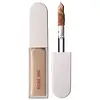What's inside
What's inside
 Key Ingredients
Key Ingredients

 Benefits
Benefits

 Concerns
Concerns

No concerns
 Ingredients Side-by-side
Ingredients Side-by-side

Water
Skin ConditioningCaprylic/Capric Triglyceride
MaskingBis-Diglyceryl Polyacyladipate-2
EmollientVp/Hexadecene Copolymer
Cetyl Alcohol
EmollientOzokerite
Emulsion StabilisingSilica Dimethyl Silylate
EmollientPhytosteryl Macadamiate
Skin ConditioningPhenoxyethanol
PreservativeChlorhexidine Digluconate
AntimicrobialEthylhexylglycerin
Skin ConditioningHydrolyzed Collagen
EmollientTocopheryl Acetate
AntioxidantAscorbyl Palmitate
AntioxidantRetinyl Palmitate
Skin ConditioningGlycerin
HumectantPropylene Glycol
HumectantSodium Hyaluronate
HumectantSteareth-20
CleansingLecithin
EmollientMagnesium Ascorbyl Phosphate
AntioxidantTocopherol
AntioxidantN-Hydroxysuccinimide
Skin ConditioningChrysin
Skin ConditioningPotassium Sorbate
PreservativePalmitoyl Tripeptide-1
Skin ConditioningPalmitoyl Tetrapeptide-7
Skin ConditioningCI 77891
Cosmetic ColorantCI 77007
Cosmetic ColorantIron Oxides
Water, Caprylic/Capric Triglyceride, Bis-Diglyceryl Polyacyladipate-2, Vp/Hexadecene Copolymer, Cetyl Alcohol, Ozokerite, Silica Dimethyl Silylate, Phytosteryl Macadamiate, Phenoxyethanol, Chlorhexidine Digluconate, Ethylhexylglycerin, Hydrolyzed Collagen, Tocopheryl Acetate, Ascorbyl Palmitate, Retinyl Palmitate, Glycerin, Propylene Glycol, Sodium Hyaluronate, Steareth-20, Lecithin, Magnesium Ascorbyl Phosphate, Tocopherol, N-Hydroxysuccinimide, Chrysin, Potassium Sorbate, Palmitoyl Tripeptide-1, Palmitoyl Tetrapeptide-7, CI 77891, CI 77007, Iron Oxides
Water
Skin ConditioningC9-12 Alkane
SolventGlycerin
HumectantPropanediol
SolventTribehenin
EmollientPentylene Glycol
Skin ConditioningPolyglyceryl-3 Polyricinoleate
EmulsifyingSorbitan Isostearate
EmulsifyingDisteardimonium Hectorite
StabilisingCaprylic/Capric Triglyceride
MaskingCoco-Caprylate/Caprate
EmollientSqualane
EmollientRanunculus Ficaria Extract
Skin ConditioningAcmella Oleracea Extract
Skin ProtectingSodium Hyaluronate
HumectantLysine
Skin ConditioningTocopherol
AntioxidantMagnesium Chloride
Aluminum Hydroxide
EmollientGlyceryl Caprylate/Caprate
EmollientSodium Lauroyl Glutamate
CI 77891
Cosmetic ColorantIron Oxides
Water, C9-12 Alkane, Glycerin, Propanediol, Tribehenin, Pentylene Glycol, Polyglyceryl-3 Polyricinoleate, Sorbitan Isostearate, Disteardimonium Hectorite, Caprylic/Capric Triglyceride, Coco-Caprylate/Caprate, Squalane, Ranunculus Ficaria Extract, Acmella Oleracea Extract, Sodium Hyaluronate, Lysine, Tocopherol, Magnesium Chloride, Aluminum Hydroxide, Glyceryl Caprylate/Caprate, Sodium Lauroyl Glutamate, CI 77891, Iron Oxides
 Reviews
Reviews

Ingredients Explained
These ingredients are found in both products.
Ingredients higher up in an ingredient list are typically present in a larger amount.
This ingredient is an emollient, solvent, and texture enhancer. It is considered a skin-softener by helping the skin prevent moisture loss.
It helps thicken a product's formula and makes it easier to spread by dissolving clumping compounds.
Caprylic Triglyceride is made by combining glycerin with coconut oil, forming a clear liquid.
While there is an assumption Caprylic Triglyceride can clog pores due to it being derived from coconut oil, there is no research supporting this.
Learn more about Caprylic/Capric TriglycerideCi 77891 is a white pigment from Titanium dioxide. It is naturally found in minerals such as rutile and ilmenite.
It's main function is to add a white color to cosmetics. It can also be mixed with other colors to create different shades.
Ci 77891 is commonly found in sunscreens due to its ability to block UV rays.
Learn more about CI 77891Glycerin is already naturally found in your skin. It helps moisturize and protect your skin.
A study from 2016 found glycerin to be more effective as a humectant than AHAs and hyaluronic acid.
As a humectant, it helps the skin stay hydrated by pulling moisture to your skin. The low molecular weight of glycerin allows it to pull moisture into the deeper layers of your skin.
Hydrated skin improves your skin barrier; Your skin barrier helps protect against irritants and bacteria.
Glycerin has also been found to have antimicrobial and antiviral properties. Due to these properties, glycerin is often used in wound and burn treatments.
In cosmetics, glycerin is usually derived from plants such as soybean or palm. However, it can also be sourced from animals, such as tallow or animal fat.
This ingredient is organic, colorless, odorless, and non-toxic.
Glycerin is the name for this ingredient in American English. British English uses Glycerol/Glycerine.
Learn more about GlycerinSodium Hyaluronate is hyaluronic acid's salt form. It is commonly derived from the sodium salt of hyaluronic acid.
Like hyaluronic acid, it is great at holding water and acts as a humectant. This makes it a great skin hydrating ingredient.
Sodium Hyaluronate is naturally occurring in our bodies and is mostly found in eye fluid and joints.
These are some other common types of Hyaluronic Acid:
Learn more about Sodium HyaluronateTocopherol (also known as Vitamin E) is a common antioxidant used to help protect the skin from free-radicals and strengthen the skin barrier. It's also fat soluble - this means our skin is great at absorbing it.
Vitamin E also helps keep your natural skin lipids healthy. Your lipid skin barrier naturally consists of lipids, ceramides, and fatty acids. Vitamin E offers extra protection for your skin’s lipid barrier, keeping your skin healthy and nourished.
Another benefit is a bit of UV protection. Vitamin E helps reduce the damage caused by UVB rays. (It should not replace your sunscreen). Combining it with Vitamin C can decrease sunburned cells and hyperpigmentation after UV exposure.
You might have noticed Vitamin E + C often paired together. This is because it is great at stabilizing Vitamin C. Using the two together helps increase the effectiveness of both ingredients.
There are often claims that Vitamin E can reduce/prevent scarring, but these claims haven't been confirmed by scientific research.
Learn more about TocopherolWater. It's the most common cosmetic ingredient of all. You'll usually see it at the top of ingredient lists, meaning that it makes up the largest part of the product.
So why is it so popular? Water most often acts as a solvent - this means that it helps dissolve other ingredients into the formulation.
You'll also recognize water as that liquid we all need to stay alive. If you see this, drink a glass of water. Stay hydrated!
Learn more about WaterThis ingredient is a combination of red, black, and yellow iron oxide pigments. This combination of colors is usually found in foundation, because it results in a "skin" color.